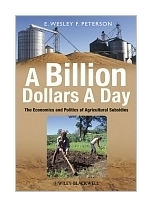|
||
• wydawnictwa polskie
• Zamów informacje o nowościach z wybranego tematu • kontakt
• Cookies na stronie |
A BILLION DOLLARS A DAY: THE ECONOMICS AND POLITICS OF AGRICULTURALWESLEY E. PETERSON F. / SUBSIDIES /wydawnictwo: WILEY BALCKWELL , rok wydania 2009, wydanie Icena netto: In a lively, non-technical, and up-to-date account, this book addresses
the core questions that surround the issues of agricultural subsidies.
E. Wesley F. Peterson is a Professor of Agricultural Economics at the University of Nebraska-Lincoln. He holds a BA in Anthropology from the University of California-Berkeley, a Masters in Public Affairs from Princeton University and a PhD in Agricultural Economics from Michigan State University. He was a Faculty Member at a French agribusiness institute and at Texas A&M University before moving to Nebraska. His research and teaching interests are in the areas of international agricultural trade, agricultural policy, and agricultural development in low-income countries. He is the author of The Political Economy of Agricultural, Natural Resource, and Environmental Policy Analysis (Iowa State University Press, Ames, IA 2001) and has authored and co-authored numerous journal articles and other publications. Table of Contents
List of Tables and Figures. Preface. List of Abbreviations. Prologue. Chapter 1: Introduction: The Problem of Agricultural Subsidies. Benin. Western Agricultural Subsidies. Organization of the Book. Chapter 2: The Economics of Government Intervention. Introduction. The Invisible Hand. Market Failures. Violation of the Basic Conditions: Imperfect Competition, Information and Risk. Public Goods and Externalities. Income Distribution, Poverty and Inequality. Conclusion. Appendix 2-1: The Theory of the Invisible Hand. Appendix 2-2: The Prisoners’ Dilemma. Chapter 3: The Structure of the World Food System. Introduction. Historical Perspectives. The World Food System. Agribusiness, Government and Science. Conclusion. Appendix 3-1: Country and Commodity Classifications used in Statistical Tables. Chapter 4: Global Institutions and the World Trade Organization. Introduction. The World Trade Organization. Agriculture in the WTO. Trade and Development. Appendix 4-1: Comparative Advantage. Chapter 5: The Nature and Scope of Agricultural Subsidies in High-Income Countries. Introduction. Agricultural Policy Objectives and Tools. Agricultural Subsidies in OECD Countries. Effects of OECD Agricultural Subsidies. Conclusion. Chapter 6: U.S. Agricultural Policy: How Not to Save the Family Farm. Introduction. Historical Overview of U.S. Farm Policy. The Impacts of U.S. Farm Subsidies. The Politics of U.S. Agricultural Policy. Appendix 6-1: ERS Farm Typology. Chapter 7: Agricultural Policy in the European Union: Europe’s Sacred Cows. Introduction. Agricultural Policy in the European Union. The Impact of the Common Agricultural Policy. Appendix 7-1: Green Currencies and the Re-Nationalization of the CAP. Chapter 8: Agricultural Policy on the Pacific Rim: Non-Trade Concerns Versus Comparative Advantage. Introduction. Japan and Korea. Australia and New Zealand. Conclusion. Chapter 9: Agricultural Policy in Developing Countries: Cheap Food. Introduction. The Developing World. Agricultural Policy in Developing Countries. The Impacts of Agricultural and Trade Policy Reforms. Conclusion. Appendix 9-1: Country Lists. Chapter 10: Conclusion: Whither Agricultural Policy?. References. Index 320 pages, Paperback Księgarnia nie działa. Nie odpowiadamy na pytania i nie realizujemy zamówien. Do odwolania !. |


